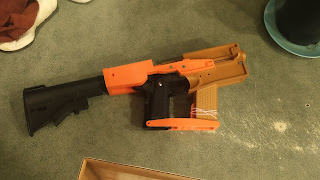I suppose you're never really done until you give up.
Over the past week or so since uploading the HCC-2A, it's gotten a ton of attention (relatively) on Thingiverse, and I've had several people inquire about purchasing a kit from me. The more inquiries I get, the more aspects of the project I become slightly uncomfortable about.
Namely:
-The stock mount, as picture above, is theoretically very fragile. If the kit is dropped, it is likely to break and become unusable.
-The muzzle plate's threading for the mock suppressor is too tight and inconsistent, which makes it very hard to screw the mock suppressor into place, and very easy to pull the threads out.
-The rear receiver and stock mount profiles aren't 100% the same, which I initially hadn't noticed because I was sanding most of the parts.
As such, I've decided to address these problems, and will do so in this post one-by-one.
The Stock Mount
When originally designed, I had intended to print the stock mount out of Taulman 645 Nylon for "production" models. As such, I decided to give this a try.
This is the PLA print of the stock mount, but the Nylon version failed in the same way.
After printing the Nylon version, I put moderate pressure on it with my hand. The end result looked just like the above image. After printing a new design of the stock mount, I tried breaking the old PLA stock mount the same way. It held up SIGNIFICANTLY better.
This launched me into a six-hour research mission into isotropy in FDM printing. As it turns out, PLA actually is one of the closest FDM filament materials to achieving true isotropy, even if the medium by nature is anisotropic.
With this part failing in both PLA and Nylon, I decided to re-design the component.
Not pretty, but it's significantly stronger.
While still having the same issues with anisotropy as the buffer tube mounting cylinder, this extra perimeter around the cylinder is much shorter, so more torque can be applied to the furthest point of it. Because of this, the buffer tube is now double-insulated by the mount, and it can withstand a significant amount of force.
The Muzzle Plate
The next issue, then, was the muzzle plate. The solution for this issue is still on-going, but essentially, I'll be relaxing the thread pitch quite a bit on both the muzzle plate and the mock suppressor. Over-aggressive thread pitches in 3D printing tend to not hold up very well - however, the issue here was not the threads themselves sustaining damage, but the cylinder the threads are built into itself separating from the muzzle plate when the mock suppressor is tightened.
The Receiver Profile
Finally, the geometry of the receiver and stock plate needed to be unified. I fixed this by doing what I should have done in the first place, a skill that has become essential in designing consistent, complex mechanical components: Boolean logic operators. In Blender, you can use a Boolean modifier on a set of parts. You can use one of these parts as the "cutting tool" for the other. Essentially, what I did was that I oversized the rear receiver and stock plate, created another object of two large, identical extrusions in the desired profile, and used that as a Boolean cutting tool to enforce an identical profile to the shape of the stock mount and the rear receiver. The screw holes in the rear receiver then needed to be re-aligned to ensure they were centered. After achieving this, the end result was a much more consistent shape over all.
Conclusion
With these issues addressed, the kit is a much more robust, accurate, and interesting option for those with TM Hi-CAPA 5.1's and a desire for a carbine kit.
I no longer sell these kits to order. It seems everyone expected a fully printed, hand-finished and fitted kit to cost about $5, and they disappeared when seeing $60. Oh well! Go print your own! :-)
Thanks for reading.
-Craig, JTW


























